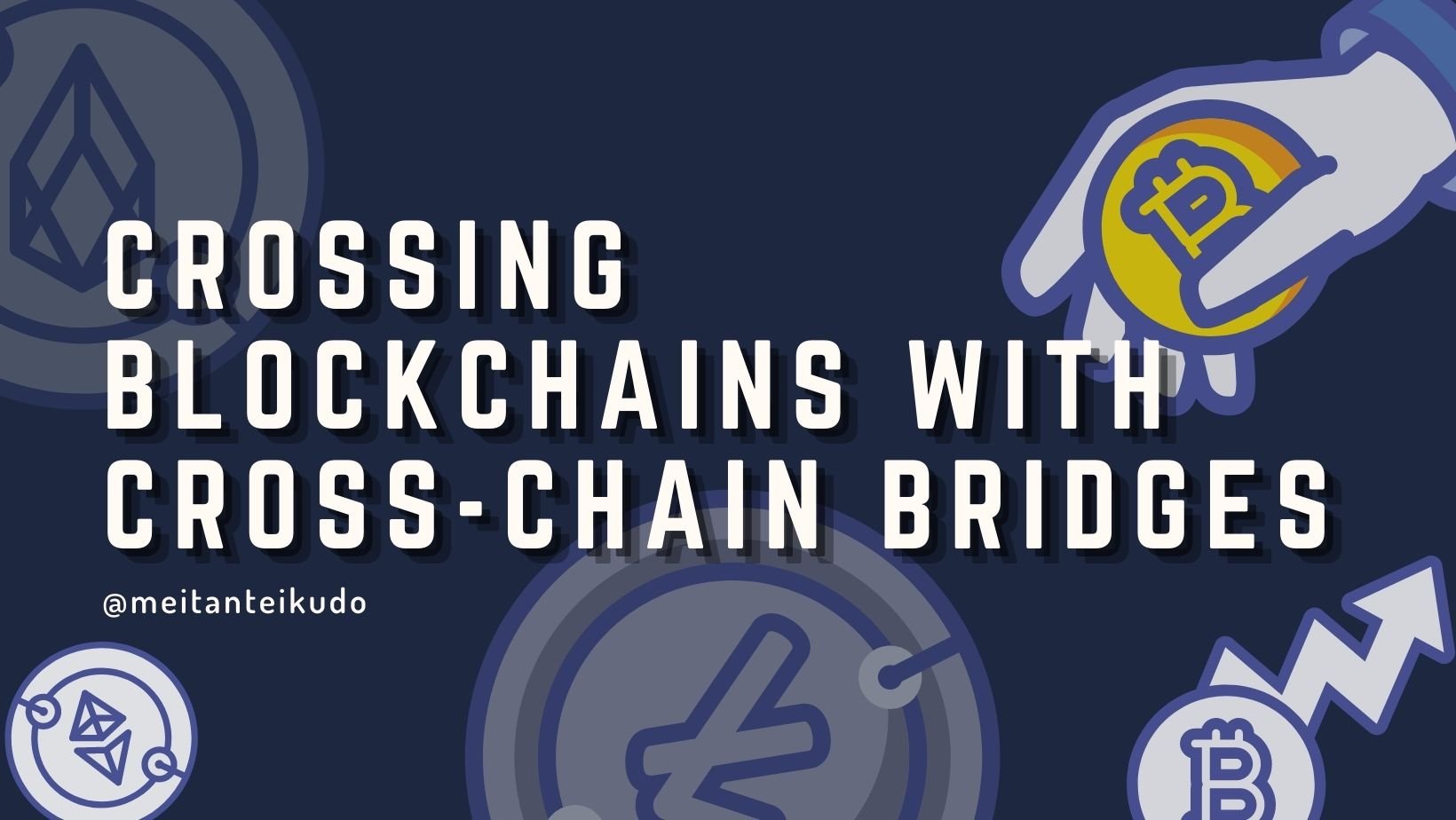Crossing Blockchains with Cross-chain Bridges

One of the limitations native to cryptocurrency coins like Bitcoin, Bitcoin Cash, or Ether is they are confined to their own blockchain. We know that all transactions made with any coin are recorded and stored to their own respective blockchain. When you spend, buy, or transfer Bitcoin, the record of your transactions will be saved in the bitcoin blockchain. In the same manner, when you buy or sell Ether, the records will be recorded in Ethereum blockchain.
This basically means that the movements of the coins are within the bounds of their respective blockchains. That's well and good but it's a limitation that beats the purpose if we are pushing cryptocurrency to be a universal currency.
How Cross-Chain Bridges Work
Let's say you have a bunch of bitcoin cash and there is a project that you are excited about. You want to invest in that project and you want to use a portion of your bitcoin cash holdings to buy into it. But upon closer observation, you realized that the project will run in the Ethereum blockchain and the funds required must be in Ether.
Now you are sitting there feeling defeated because you thought that your bitcoin cash is useless for that project. And then you drank some coffee and your brain started to function again. You thought that you can trade your BCH to ETH using some exchanges. That's a really sound idea.
First, you send your BCH to an exchange. You place an order against BCH and ETH with BCH as payment. That's lucky if the exchange you use has that very same pair. But traditionally, you will need to trade your BCH to a stable coin like USDT or Tether and then you exchange the USDT to ETH. And after you get your hands on some ETH, you send those ETH to a wallet that you can use for that project.
It's fairly easy, but by the time you have converted your BCH to ETH, you have incurred more fees than you would like to pay for.
And that's where blockchain bridges or cross-chain bridges come in. Cross-chain bridges will let you spend your BTC directly on ETH blockchain without having to go through the trouble of trading and paying unnecessary fees.
You can think of these cross-chain bridges just like real-life bridges. Your coin can cross from one blockchain to another side or another blockchain.
That's the idea. So straightforward. But the mechanism that runs the bridges requires a super smart brain. Luckily, we have "smart contracts" that enable the bridges to come into existence. Smart contracts allow us to cross the bridge as we get there.
Smart Contracts
Smart contracts are programs stored on a blockchain that processes information and executes a specific set of procedures if the information processed met the conditions and requirements set.
My brain isn't smart enough to explain it down to the letter but here's how I understand it.
You can ask anybody that knows a thing or two about cryptocurrency blockchains and they will tell you that a blockchain is nothing but a huge "ledger". It is basically a long list of in's and out's and a record of all the transactions that happened to the specific currency. There is no process involved. The ledger or the blockchain doesn't process any information nor does it compute anything, it just stores records.
Smart contracts allow for these processes to take place inside the blockchain. Smart contracts can tell the blockchain, what to do with the funds and when. The smart contracts will process such requests and when the output met the conditions and requirements set, then it tells the blockchain to record the transaction.
In a nutshell, smart contracts allow bridges to work. I imagine the process to be something like this: A smart contract will hold and lock the BCH you are willing to spend on the BCH blockchain and then that same smart contract will tell the Ethereum blockchain to mint the same worth of that BCH on the Ethereum blockchain.
Let us say that you tried to send 10 BCH over to the Ethereum blockchain to be used for the project that you are enthusiastic about. The smart contract will hold that 10 BCH and will mint 10 BCH over the other Ethereum blockchain. You can then withdraw the same or what's left of your 10 BCH back to the native bitcoin cash blockchain and the minted counterpart on the Ethereum blockchain will be burned.
That's one way bridges work, the other way is a little bit conventional and a bit low tech. You can read about Trustless and Trust-based bridges for more information or you can read my article about it here: Bridge, I Put My Trust In You.
That's the concept and I think that you know it in actuality as the "SmartBCH". SmartBCH is an example of a chain-cross bridge that is powered by Coinflex. It allows your BCH to have the power of Ether.
There are a lot of bridges out there. A while back, I personally used Orbit bridge to send over some of my $Skill (token used for Cryptoblades game) from Binance Smart Chain Network towards Polygon Network. The process was fairly easy and with just a minimum fee.
Pretty convenient I must say.

Hallo!!!
I think I have learned another interesting thing about cryptocurrency today. I hope that you have picked up something too with this article of mine. I didn't know that 'sbch' is an example of a bridge in action. I thought it was just magic.
I am so glad that you are still with me in my journey of understanding the cryptoverse, one thing at a time. I hope that you strap in for the wild ride.
Thank you for the visit again, and until we read again.
Cheers!!!

Author's Links
Noise | Torum | Twitter | Hive | Publish0x
Telegram: meitanteikudo
Would You Like to Earn Some More?
Passive income with your internet (gain $5 instantly by using my referral link)
Play some games and earn.
Watch, learn, and play while you earn: (Use my code for $5 bonus)
Series : All About Crypto
Title : Crossing Blockchains with Cross-chain Bridges
Published : 26-Feb-2022
Author : © RBReferences:
C. (2021, March 10). What Are Blockchain Bridges? CoinMarketCap Alexandria. Retrieved February 23, 2022, from https://coinmarketcap.com/alexandria/article/what-are-blockchain-bridges
L. (n.d.). What Are Blockchain Bridges and Why Do We Need Them? Liquid. Retrieved February 23, 2022, from https://blog.liquid.com/blockchain-cross-chain-bridge
Redman, J. (2021, September 20). Cross-Chain Bridges That Connect 5 Different Blockchains to Ethereum. Bitcoin News. Retrieved February 23, 2022, from https://news.bitcoin.com/cross-chain-bridges-that-connect-5-different-blockchains-to-ethereum/


This was really helpful.. Thanks